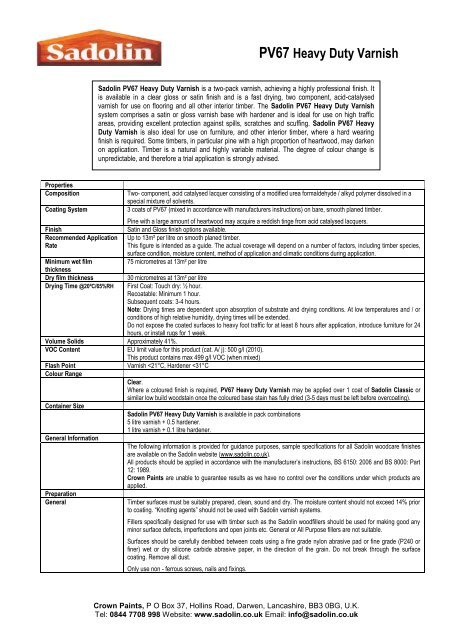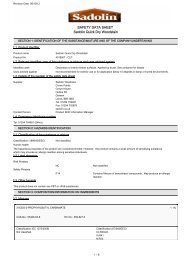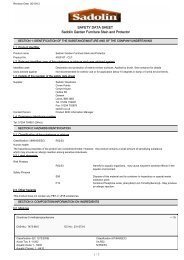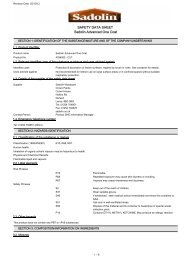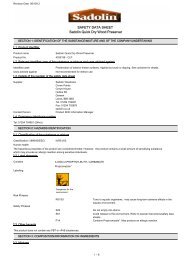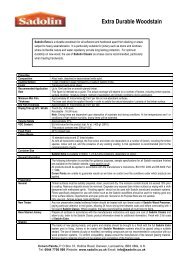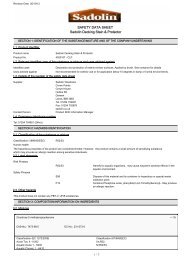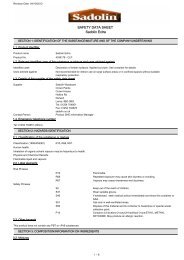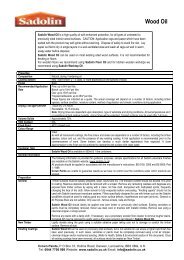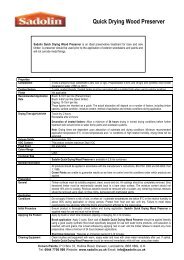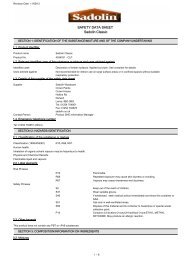Create successful ePaper yourself
Turn your PDF publications into a flip-book with our unique Google optimized e-Paper software.
<strong>PV67</strong> <strong>Heavy</strong> <strong>Duty</strong> <strong>Varnish</strong><br />
<strong>Sadolin</strong> <strong>PV67</strong> <strong>Heavy</strong> <strong>Duty</strong> <strong>Varnish</strong> is a two-pack varnish, achieving a highly professional finish. It<br />
is available in a clear gloss or satin finish and is a fast drying, two component, acid-catalysed<br />
varnish for use on flooring and all other interior timber. The <strong>Sadolin</strong> <strong>PV67</strong> <strong>Heavy</strong> <strong>Duty</strong> <strong>Varnish</strong><br />
system comprises a satin or gloss varnish base with hardener and is ideal for use on high traffic<br />
areas, providing excellent protection against spills, scratches and scuffing. <strong>Sadolin</strong> <strong>PV67</strong> <strong>Heavy</strong><br />
<strong>Duty</strong> <strong>Varnish</strong> is also ideal for use on furniture, and other interior timber, where a hard wearing<br />
finish is required. Some timbers, in particular pine with a high proportion of heartwood, may darken<br />
on application. Timber is a natural and highly variable material. The degree of colour change is<br />
unpredictable, and therefore a trial application is strongly advised.<br />
Properties<br />
Composition<br />
Coating System<br />
Finish<br />
Recommended Application<br />
Rate<br />
Minimum wet film<br />
thickness<br />
Dry film thickness<br />
Drying Time @20ºC/65%RH<br />
Two- component, acid catalysed lacquer consisting of a modified urea formaldehyde / alkyd polymer dissolved in a<br />
special mixture of solvents.<br />
3 coats of <strong>PV67</strong> (mixed in accordance with manufacturers instructions) on bare, smooth planed timber.<br />
Pine with a large amount of heartwood may acquire a reddish tinge from acid catalysed lacquers.<br />
Satin and Gloss finish options available.<br />
Up to 13m² per litre on smooth planed timber.<br />
This figure is intended as a guide. The actual coverage will depend on a number of factors, including timber species,<br />
surface condition, moisture content, method of application and climatic conditions during application.<br />
75 micrometres at 13m² per litre<br />
30 micrometres at 13m² per litre<br />
First Coat: Touch dry: ½ hour.<br />
Recoatable: Minimum 1 hour.<br />
Subsequent coats: 3-4 hours.<br />
Note: Drying times are dependent upon absorption of substrate and drying conditions. At low temperatures and / or<br />
conditions of high relative humidity, drying times will be extended.<br />
Do not expose the coated surfaces to heavy foot traffic for at least 8 hours after application, introduce furniture for 24<br />
hours, or install rugs for 1 week.<br />
Volume Solids Approximately 41%.<br />
VOC Content EU limit value for this product (cat. A/ j): 500 g/l (2010).<br />
This product contains max 499 g/l VOC (when mixed)<br />
Flash Point<br />
Colour Range<br />
Container Size<br />
General Information<br />
Preparation<br />
General<br />
<strong>Varnish</strong>
New Timber<br />
Existing Coatings<br />
Application<br />
Conditions<br />
Initial Procedure<br />
Applying the Product<br />
Maintenance<br />
Cleaning Equipment<br />
Storage<br />
Resinous deposits should be removed with a scraper. Remove any remaining residues and degrease any exposed<br />
bare timber surface by wiping with a clean, lint free cloth, moistened with methylated spirits frequently changing the<br />
face of the cloth. Allow solvent to fully evaporate before overcoating. Lightly abrade along the grain using a suitable<br />
abrasive paper taking care not to damage or scratch the timber surface. Remove all dust.<br />
<strong>Sadolin</strong> <strong>PV67</strong> <strong>Heavy</strong> <strong>Duty</strong> <strong>Varnish</strong> should not be applied to conventional single pack varnishes, either water borne<br />
or solvent borne. If in any doubt about the nature of the existing finish, it must be completely removed back to clean,<br />
bright timber and the retreated as ‘New Timber’.<br />
Warm and dry weather conditions assure proper drying/curing. Excessive humidity or low temperature will affect the<br />
chemical reaction in the finish, causing incomplete drying/curing. The formaldehyde release period can also be<br />
negatively affected. To minimise such problems, application of <strong>PV67</strong> <strong>Heavy</strong> <strong>Duty</strong> <strong>Varnish</strong> is recommended between<br />
18-25°C and not above 65% relative humidity. If there is any doubt regarding the level of humidity present, a<br />
dehumidifier should be used prior to, during, and immediately after the application of <strong>PV67</strong>. Good air flow and<br />
ventilation are essential, there must be good ventilation at ground level during and after application. Where air<br />
circulation is poor, we recommend the use of electric fans to assist air movement. Do not direct drafts at the surface.<br />
The moisture content of the timber should be allowed to stabilise to the conditions within the room, and should not<br />
exceed 14%. <strong>PV67</strong> <strong>Heavy</strong> <strong>Duty</strong> <strong>Varnish</strong> is ready to use in its combined form and does not require thinning. It is not<br />
recommended to increase the speed of drying by using additional hardener. Protect from water until dry.<br />
Do not apply to wood species with a heavy oil content without thorough surface preparation, i.e. sanding and<br />
degreasing with a sharp solvent and if necessary a trial application<br />
Do not over and under dose hardener. The exact amount is very important.<br />
Do not apply over floors that have been bleached.<br />
Do not apply over conventional single pack varnishes either water or solvent borne. If in any doubt about the nature<br />
of the existing finish it must be completely removed back to clean bright timber and treated as new.<br />
Do not allow heavy traffic for at least eight hours after application<br />
Do not install furniture until 24 hours after application<br />
Do not install rugs until one week after application.<br />
Newly applied surfaces should be allowed one week complete curing time before any cleaning is undertaken.<br />
Ensure product is thoroughly stirred before and during application, otherwise sheen and colour variations may be<br />
experienced. <strong>Sadolin</strong> <strong>PV67</strong> <strong>Heavy</strong> <strong>Duty</strong> <strong>Varnish</strong> is mixed in the ratio of 10 parts varnish to 1 part hardener, by<br />
volume. The varnish / hardener mixture must be thoroughly shaken immediately prior to use. As the hardener<br />
contains acid, mixing should only take place in suitable vessels such as plastic, glass or an undamaged enamel<br />
vessel.<br />
Note: Once the 2 components of the varnish have been mixed, the product can be stored in a closed container below<br />
20°C and remains useable for up to 3-4 hours, however we strongly recommend only mixing sufficient material for<br />
individual coats at any one time.<br />
<strong>Sadolin</strong> <strong>PV67</strong> <strong>Heavy</strong> <strong>Duty</strong> <strong>Varnish</strong> should be applied in full flowing coats ensuring all surfaces are fully coated. For<br />
best results use a soft bristle brush, lambs wool applicator or quality woven short to medium pile roller. Clean<br />
application tools must be used ensuring any fibre shed is removed prior to use by thorough washing (then allow to<br />
fully dry) or by using masking tape. Following surface preparation in accordance with the manufacturers<br />
recommendations, finish with 3 full coats of <strong>Sadolin</strong> <strong>PV67</strong> <strong>Heavy</strong> <strong>Duty</strong> <strong>Varnish</strong> allowing a minimum of 3-4 hours<br />
drying between coats. Avoid over brushing as this will cause brush marks and result in a poor quality finish and also<br />
reduce the level of protection afforded. Carefully denib the fist coat using a fine grade nylon abrasive pad or a fine<br />
grade (P240 or finer) wet or dry silicone carbide abrasive paper in the direction of the grain before overcoating. Do not<br />
break through the surface coating. Remove all dust.<br />
All subsequent coatings should be applied as soon as possible after the previous coat has fully cured.<br />
Remove any defective coatings. Organic growths must be removed and infected surfaces should be treated with a<br />
suitable fungicidal solution. Remaining sound surfaces should be cleaned using a warm water and mild detergent and<br />
rinsed thoroughly with clean water. Allow to completely dry. Bare timber should be patch primed with one coat of<br />
<strong>Sadolin</strong> <strong>PV67</strong> <strong>Heavy</strong> <strong>Duty</strong> <strong>Varnish</strong>. Finish with 1 or 2 coats of <strong>Sadolin</strong> <strong>PV67</strong> <strong>Heavy</strong> <strong>Duty</strong> <strong>Varnish</strong> as required.<br />
Care and maintenance of floors coated with <strong>Sadolin</strong> <strong>PV67</strong>.<br />
<strong>PV67</strong> varnish treated floors must not be cleaned with wax polishes, strong detergents or caustic soda. A clean down<br />
with mild detergent and water is all that is required. Do not flood the surface with water. The surface should then be<br />
buffed with a dry cloth to mop to restore the sheen. Acrylic emulsion “dressings” may be applied as necessary to<br />
improve abrasion resistance, restore shine and help to cover minor scratches. Follow manufacturer’s instructions.<br />
If maintenance becomes necessary, the surfaces should be lightly sanded with a fine grade abrasive paper. Remove<br />
all dust completely and apply one coat of <strong>PV67</strong> <strong>Varnish</strong> (two component). It is possible to maintain small areas of<br />
worn varnish by “feathering” the maintenance coat into the surrounding varnish after using a fine grade abrasive<br />
paper to prepare the surface. Coatings in a poor condition should be removed completely. Emulsion dressings must<br />
be removed before maintaining with <strong>PV67</strong> <strong>Varnish</strong>.<br />
Newly applied surfaces should be allowed one week complete curing time before any cleaning is undertaken.<br />
Clean brushes and equipment with a proprietary brush cleaner immediately after use. If spilled, <strong>Sadolin</strong> <strong>PV67</strong> <strong>Heavy</strong><br />
<strong>Duty</strong> <strong>Varnish</strong> should be removed immediately while still wet, using clean cellulose thinners or methylated spirits<br />
Ensure this pack is stored upright and secure at all times. Crown Paints Limited cannot accept liability for damage<br />
caused by spillage. Do not store below 5°C or above 40°C.<br />
Crown Paints, P O Box 37, Hollins Road, Darwen, Lancashire, BB3 0BG, U.K.<br />
Tel: 0844 7708 998 Website: www.sadolin.co.uk Email: info@sadolin.co.uk
Relevant Standards<br />
Health, Safety and the<br />
Environment<br />
BS 6150: 2006 - Code of practice for painting of buildings.<br />
BS 8000: Part 12: 1989 - Workmanship on building sites. Code of practice for decorative wallcoverings and painting.<br />
Information on British Standards can be obtained from the British Standards Institute, tel: 0208 996 9001.<br />
It is the policy of Crown Paints to provide the highest standard of safety, health and environmental advice and<br />
information. To this end, material safety data sheets covering every product are supplied to our customers and are<br />
freely available to users on request, by contacting us on the number given below. The safety phrases on the<br />
containers and material safety data sheets should be read before using this product.<br />
Removal of lead paint. Take special precautions during the surface preparation of pre 1960’s painted surfaces as<br />
they may contain harmful lead. Remove all such coating materials in accordance with the appropriate legislation. A<br />
guide on “How to remove old lead paint safely” is available via the British Coatings Federation Ltd. (Tel. 01372<br />
360660).<br />
Surface Preparation and Applications. Treatments such as sanding and burning off, etc. of paint films may<br />
generate hazardous dust and/or fumes. Work in well ventilated areas. Use suitable personal respiratory equipment<br />
together with any other Personal Protection Equipment (PPE) as necessary.<br />
Environment. Crown Paints are committed to achieving the highest standards of health and safety at work and to<br />
minimising any impact our operations and products may have on the quality of the environment. We will provide such<br />
information as is necessary to customers to ensure so far as is reasonably practicable that our products can be used,<br />
transported, stored and disposed of safely without risk to health or the environment.<br />
It is recommended that any waste material be taken to a household waste disposal site provided by your Local<br />
Authority. Do not empty waste materials into drains, watercourses or access routes to septic tanks.<br />
Customer Service. For help or more information contact our Customer Relations Team on 0844 7708 998. Before<br />
using this product please ensure you have the latest information.<br />
The above information is correct at the date of issue, May 2014.<br />
Crown Paints, P O Box 37, Hollins Road, Darwen, Lancashire, BB3 0BG, U.K.<br />
Tel: 0844 7708 998 Website: www.sadolin.co.uk Email: info@sadolin.co.uk


